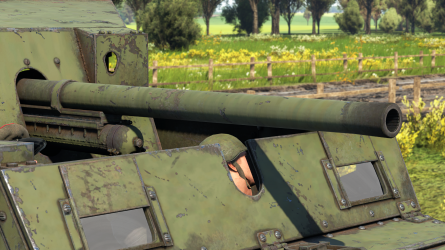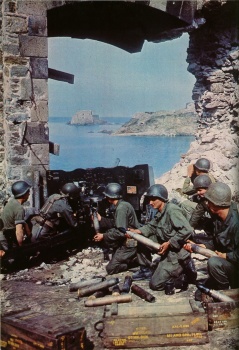M1 (57 mm)
Contents
Description
The 57 mm M1 is an American anti-tank cannon derived from the British 6-pounder cannon. Firing a small-diametre round at high velocity, the 57 mm M1 offers good close-range penetration values, but suffers at long-range combat.
Vehicles equipped with this weapon
General info
Tell us about the tactical and technical characteristics of the cannon or machine gun.
Available ammunition
| Penetration statistics | |||||||
|---|---|---|---|---|---|---|---|
| Ammunition | Type of warhead |
Penetration @ 0° Angle of Attack (mm) | |||||
| 10 m | 100 m | 500 m | 1,000 m | 1,500 m | 2,000 m | ||
| M70 | AP | 118 | 114 | 97 | 80 | 66 | 54 |
| M86 | APCBC | 122 | 118 | 103 | 87 | 73 | 62 |
| Shell details | ||||||||||||
|---|---|---|---|---|---|---|---|---|---|---|---|---|
| Ammunition | Type of warhead |
Velocity (m/s) |
Projectile mass (kg) |
Fuse delay (m) |
Fuse sensitivity (mm) |
Explosive mass (TNT equivalent) (g) |
Ricochet | |||||
| 0% | 50% | 100% | ||||||||||
| M70 | AP | 900 | 2.85 | - | - | - | 47° | 60° | 65° | |||
| M86 | APCBC | 822 | 3.29 | 1.2 | 9 | 41.16 | 48° | 63° | 71° | |||
Comparison with analogues
Give a comparative description of cannons/machine guns that have firepower equal to this weapon.
Usage in battles
Describe the cannon/machine gun in the game - its distinctive features, tactics of usage against notable opponents. Please don't write a "guide" - do not impose a single point of view, but give the reader food for thought.
Pros and cons
Pros:
- Good close-range penetration values
- Fast reloading times
Cons:
- Penetration value drops off quickly over range
- Small diameter rounds cause little post-penetration damages
- Only two rounds available, an AP and APCBC round
History
Development
At the start of 1941, the most impressive anti-tank cannon available to the United States was the 37 mm M3 anti-tank gun. However, this cannon was deemed not adequate against the trend of improving tank armour.[1] Plans to produce a more powerful gun came in February 1941, when the Chief of Ordnance ordered the British 6-pounder to begin manufacture in America.[2] The British assisted by providing two 6-pdr Mk.II anti-tank cannons for reference.[2]
Changes were made to the design to suit American manufacture. The most significant was the barrel length, as the British 6-pdr Mk.II cannon featured a shorter barrel length than the Mk.I due to limited production capability in Britain for the long barrel. The United States, with no such limitations, restored the longer barrel design. With these design changes, the American-produced 6-pounder were designated as the 57 mm gun M1. However, the weapon was not adopted by US forces, only classified a substitute standard by late 1941 with intentions of providing the weapon in Lend-Lease.[2] Its production would last from 1942 to 1945, with a total of 15,637 units produced.[3]
Despite its improved performance, the 57 mm M1 was not eagerly taken by the US forces. Most complaints stem from its weight increase, from the 910 lb. 37 mm gun to the 2,100 lb. 57 mm gun. As such, the Infantry, Airborne, and Cavalry all initially rejected it. It was not until US experience in North Africa that showed the desperate need of better anti-tank power that the 57 mm was begrudgingly accepted into service in the Spring of 1943. However, the rushed adoption of the weapon also presented problems as the production lines only produced armour-piercing ammunition. As such, rounds such as high-explosive and cannister that were available for the 37 mm were not yet designed, forcing American units to acquire high-explosive rounds from British stockpile. Though attempts were made to design and produce a high-explosive and cannister round, they came too late for significant use in the European Theater of Operations (ETO).[4]
American combat usage
The 57 mm M1 first saw usage in the Italian campaign, serving alongside its preceding 37 mm counterpart due to the ongoing transition in equipment in 1943.[3] It was not until the Normandy campaign that the 57 mm M1 saw more widespread usage, even among the Airborne after the British designed a light-weight variant to fit into gliders. The lack of other ammunition types for the gun was prevalent, as it hinders the gun's ability to support infantry when attacking fortifications.[5] The towed nature of the rather heavy 57 mm also restricted its usage as it prevents the crew from being able to move the gun quickly in the close fighting of the bocage terrain.[6] Despite these problems, the 57 mm M1 gun helped bolster the infantry's ability to defend against German armoured attacks, such as during the battle in Isigny against the Panzer Lehr Division and the defense against the German Operation Lüttich at Mortain.[6][7] After the Battle of the Bulge, the 57 mm M1 saw dwindling use, not only due to its inability to deal with the newer German tanks like the Tiger and Panther, but because the reduced German armour presence in the theater after the battle meant it was rarely used. Several anti-tank companies within infantry were either converted to rifle companies or reequipped with bazookas.[8]
Foreign usage
The 57 mm M1 saw widespread use under Lend-Lease aid, with a total of 5,352 of the produced guns being sent out. The majority (4,242 units) went towards Great Britain to supplement their supply of available 6-pounder guns. The next major recipient was Free French forces, which received 653 guns. The USSR and Latin America also received 400 and 57 units respectively.[9] The USSR impressions of the gun, when compared to their domestic designs, only consider it suitable for static defences.[10]
Media
- Images
See also
- 6pdr OQF Mk.III (57 mm) - British equivalent of the weapon, though with a shorter barrel and so with slightly lower penetration values
- 6pdr OQF Mk.V (57 mm) - British equivalent of the weapon, with the same barrel length and so with more similar penetration values
External links
- References
- Bibliography
- Henry, Chris. British Anti-tank Artillery 1939-45. Osprey Publishing Ltd., 2004.
- Samsonov, Peter. "Lend Lease Impressions: 57 mm M1 Anti-tank Gun" Tank Archives 02 Oct 2017, Website, Accessed 18 Jan 2021.
- Zaloga, Steven J. US Anti-tank Artillery 1941-45. Osprey Publishing Ltd., 2005.
| USA tank cannons | |
|---|---|
| 20 mm | M139 |
| 25 mm | LW25 · M242 |
| 37 mm | M3 · M5 · M6 |
| 57 mm | M1 |
| 75 mm | M2 · M2 Howitzer · M3 · M6 · M1897A4 · XM274 |
| 76 mm | M1 · M7 · M32 · T185E1 |
| 90 mm | M3 · M3A1 · M36 · M41 · M54 · T15E1 · T15E2 · T54 · T208E9 |
| 105 mm | M4 · M68 · M68A1 · M68A1E8 · T5E1 · T5E2 · T140E2 · T140E3 · XM35 |
| 106 mm | M40A1C |
| 120 mm | M58 · M256 · T53 |
| 152 mm | M81 · M162 · XM150E5 |
| 155 mm | M185 · T7 |
| 165 mm | M135 |
| Foreign: | |
| 20 mm | Rh202 (Germany) |
| 57 mm | 6pdr OQF Mk.III (Britain) · ZIS-2 (USSR) |
| 105 mm | Sharir (Israel) |
| 120 mm | IMI MG251 (Israel) |
| USSR tank cannons | |
|---|---|
| 20 mm | TNSh |
| 30 mm | 2A42 · 2A72 · AG-30 |
| 45 mm | 20-K |
| 57 mm | AU-220 · Ch-51M · ZIS-2 · ZIS-4 · ZIS-4M |
| 73 mm | 2A28 |
| 76 mm | 1902/30 · 3-K · D-56TS · F-32 · F-34 · F-96 · KT-28 · L-10 · L-11 · ZIS-3 · ZIS-5 |
| 85 mm | D-5S · D-5T · D-58 · D-70 · F-30 · ZIS-S-53 |
| 100 mm | 2A48 · 2A70 · D-10S · D-10T · D-10T2S · D-50 · LB-1 · S-34 |
| 107 mm | ZIS-6 |
| 115 mm | U-5TS |
| 122 mm | A-19 · D-25-44T · D-25S · D-25T · D-25TS · D-30T · D-49 · M-30 · M-62-T2S |
| 125 mm | 2A26 · 2A46 · 2A46M · 2A46M-1 · 2A46M-4 · 2A46M-5 · 2A46MS · 2A75 · D-126 |
| 130 mm | B-13 · C-70 · M-65 |
| 152 mm | 2A33 · LP-83 · M-10T · M-64 · M-69 · ML-20S |
| Foreign: | |
| 37 mm | M5 (USA) |
| 50 mm | KwK L/42 (Germany) |
| 57 mm | 6pdr OQF Mk.III (Britain) · M1 (USA) |
| 75 mm | KwK42 (Germany) · M2 (USA) |
| 76 mm | M1 (USA) |
| 85 mm | Type-62-85-TC (China) |








